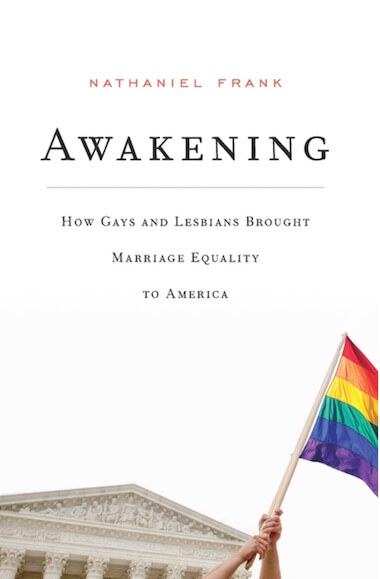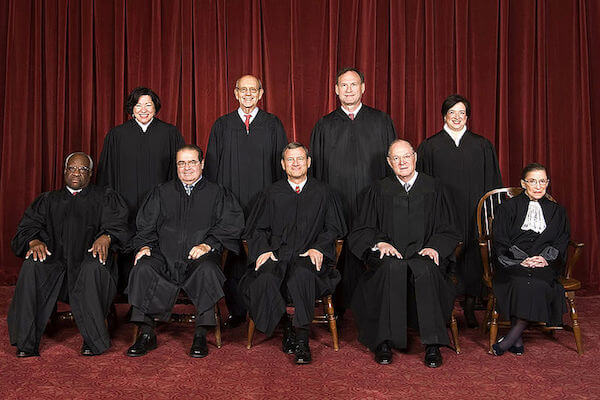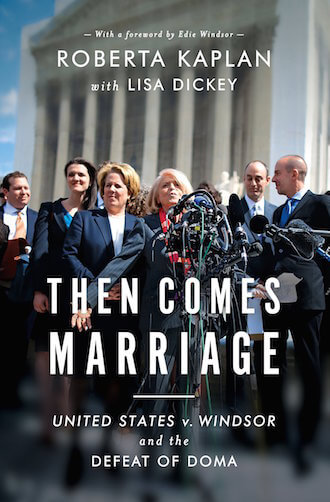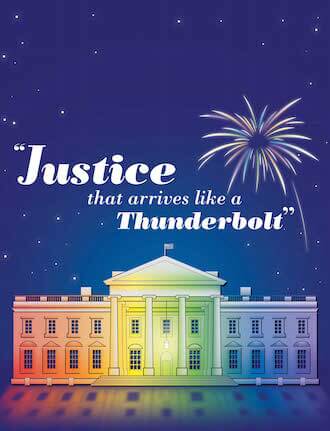ILLUSTRATION BY MICHAEL SHIREY
BY ARTHUR S. LEONARD | In the opening act of what could well be the end game, the US Supreme Court announced on January 16 that it was granting review of the Sixth Circuit Court of Appeals ruling that rejected the claim that same-sex couples have a constitutional right to marry and to have such marriages recognized by other states.
The Sixth Circuit’s ruling overturning marriage equality victories in Ohio, Michigan, Tennessee, and Kentucky, issued on November 6, opened up a split among the circuit courts of appeals. Earlier last year, the Fourth, Seventh, Ninth, and 10th Circuits had all ruled in favor of gay marriage claims, and, significantly, the Supreme Court on October 6 refused to review three of those appellate rulings. The Ninth Circuit issued its decision one day later.
As a result, marriage equality in the weeks after October 6 spread to 16 additional states under the jurisdiction of those four circuits.
Perhaps more telling was the high court’s ruling on December 19 denying a motion by Florida Republican Attorney General Pam Bondi to stay a US district court marriage equality ruling while that state appealed to the 11th Circuit Court of Appeals. The fact that a majority of the Supreme Court was not willing to stay a district court ruling not yet decided by a circuit court of appeals spoke volumes about the likely outcome of the case the high court has now taken up.
It bears remembering, however, that it is always hazardous to predict what the Supreme Court will ultimately do on an issue on which it is likely to be sharply divided.
Those curious about the types of questions the justices will pose to attorneys regarding a constitutional right for same-sex couples to marry might want to listen to the oral arguments in the Proposition 8 case the high court heard in 2013, available on its website. Those arguments led to predictions the court might strike down the 2008 California ballot initiative on a 5-4 vote. Instead, the court concluded that the group appealing the district court ruling that found Prop 8 unconstitutional –– made up of the initiative’s original proponents –– did not have legal standing to pursue their appeal. The anti-marriage initiative therefore died, but without the Supreme Court ruling on its merits.
The dissenting opinion in that case was written by Justice Anthony M. Kennedy, Jr., who was the author of the other momentous marriage decision issued on the same day, in which the court, on a 5-4 vote, struck down the Defense of Marriage Act’s ban on federal recognition of legal same-sex marriages. The DOMA ruling sparked an avalanche of marriage equality lawsuits in federal court –– and then an avalanche of rulings, the vast majority of them favorable to same-sex marriage plaintiffs.
Same-sex couples can now marry in 36 states and the District of Columbia, though ongoing disputes in Kansas have limited the jurisdictions where the right to do so is available. In a 37th state, Missouri –– which is not in a circuit where an appellate decision has been made –– another contested ruling has made marriage equality available in only a handful of counties.
The only adverse rulings since the DOMA decision came down were in district courts in Louisiana and Puerto Rico and at the Sixth Circuit Court of Appeals.
New Yorkers Joseph Vitale and Robert Talmas are among the Ohio marriage recognition plaintiffs, having gone to court to ensure that both of their names appear on the birth certificate of their Cincinnati-born adopted son Cooper. | COURTESY: JOSEPH VITALE
In accepting the Sixth Circuit cases for review, the high court announced it would devote 90 minutes of oral argument to the question of whether the 14th Amendment requires a state to license a marriage between two people of the same sex, and 60 minutes to the question of whether its requires a state to recognize such a marriage lawfully performed out-of-state. There was no word on how those blocks of time would be apportioned among the numerous parties.
On the plaintiffs’ side, all of the major LGBT rights groups are involved in some capacity in one or more of the cases and they may well draw on experienced Supreme Court litigators from major law firms who volunteer to argue such cases as cooperating attorneys. There will likely be jockeying on the plaintiffs’ side to determine who will argue on which issues.
The most pressing question, of course, is whether the court will use this case to declare a constitutional right to marry throughout the US or, at the least, to have those marriages recognized wherever a married couple might travel or reside. But to those following gay rights litigation generally, the question of what theories the court uses to decide the case will also be of significant interest, particularly since the four circuit court of appeals decisions upholding marriage equality have adopted different theories. The theory ultimately employed could have an effect on other, non-marriage litigation.
Judge Jeffrey Sutton’s opinion for the Sixth Circuit held that a 1972 Supreme Court ruling –– which dismissed a constitutional challenge to Minnesota’s ban on same-sex marriage because the case did not present a “substantial federal question” –– precludes lower courts today from ruling on marriage equality. The same reasoning was used in the Louisiana and Puerto Rico district courts’ rejection of marriage equality claims.
Those defending Prop 8 raised the same argument during oral arguments before the Supreme Court, but Justice Ruth Bader Ginsburg dismissed its significance, pointing out that in 1972 the Court had not yet issued its rulings holding that sex discrimination cases should be evaluated using heightened scrutiny, which places a higher than normal burden on the government in defending a law under challenge. Given the weight Sutton’s opinion gave to the 1972 precedent in his Sixth Circuit ruling, the issue is likely to be discussed again.
The four circuits that upheld marriage equality last year all found the 1972 precedent was no long binding, noting that subsequently the high court, in several rulings, expanded on its view that marriage is a fundamental right –– though that had already been the crux of its historic 1967 decision striking down bans on interracial marriage. The high court has also issued a string of significant gay rights rulings in the past two decades –– striking down a Colorado anti-gay constitutional amendment on equal protection grounds in 1996; finding sodomy laws unconstitutional in 2003; and ruling in 2013 that DOMA’s ban on federal recognition of legal same-sex marriages violated both the due process and equal protection rights of same-sex couples.
In short, it would be ludicrous to suggest that same-sex marriage does not present a “substantial federal question.”
Even the high court’s most outspoken opponent of gay rights, Justice Antonin Scalia, might concede that point, since his dissenting opinions in the sodomy and DOMA cases both proclaimed that the majority’s rationale would open up claims for same-sex marriage. In fact, many of the recent lower court marriage equality rulings have quoted from Scalia’s dissents to support their finding that a right of same-sex couples to marry is a logical extension of those earlier rulings.
Significantly, the Supreme Court’s opinion in the DOMA case did not even mention the 1972 precedent.
The Fourth and 10th Circuits held that same-sex couples were being deprived of a fundamental right to marry and that the states had failed to show a compelling justification for that. Ruling on that ground would likely not affect the high court’s continuing reluctance to find explicitly that sexual orientation discrimination is constitutionally suspect and can only be justified by a compelling rationale –– a holding that would be relevant in the context of other gay rights claims.
The Seventh and Ninth Circuits, in contrast, premised their decisions on equal protection grounds, with the Ninth Circuit holding that sexual orientation discrimination calls for heightened scrutiny by the courts and the Seventh Circuit’s analysis broadly following the same approach. An equal protection ruling from the Supreme Court that explicitly applies heightened scrutiny would have a more far-reaching effect in other gay rights cases outside the marriage issue –– which is why it seems more likely the high court would take the narrower route of a fundamental rights analysis.
On the other hand, justices might be leery about reaffirming too broad a fundamental marriage right, for fear it would put in play constitutional challenges to laws penalizing polygamy and incest. If a fundamental rights decision carries the day, depend on Justice Scalia to exclaim in a fiery dissent that the court is effectively gutting the right of states to limit marriage to unions of two unrelated adults.
The best prediction at this point would be at least a 5-4 vote to reverse the Sixth Circuit, most likely on due process grounds. If Justice Kennedy writes the opinion, however –– as he did in the Colorado, sodomy, and DOMA cases –– it may be that its theoretical underpinnings will be subject to debate since he has refrained from using familiar constitutional doctrinal terms in his gay-related decisions.
It is hard to explain the high court’s refusal last month to stay the Florida district court decision without predicting this outcome.
There has been some speculation that Chief Justice John Roberts might also vote to reverse the Sixth Circuit, even though he was a dissenter in the DOMA case. Roberts wrote the Prop 8 opinion for the court, effectively letting the lower court’s decision striking it down go into effect and reviving marriage equality in California. By adding his vote to a marriage equality majority, the chief justice would have the power to keep the opinion for himself or to assign it to the justice of his choice –– one way to ensure the case is decided on the narrowest grounds possible.
Recall that this appeared to be Roberts’ strategy when he voted to uphold Obamacare in 2012 and wrote the majority opinion.



































